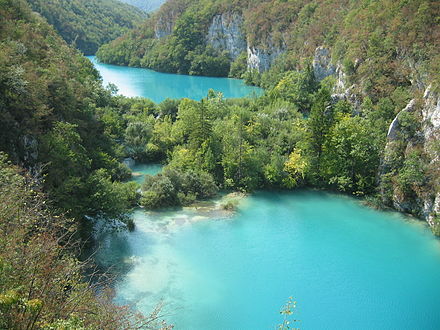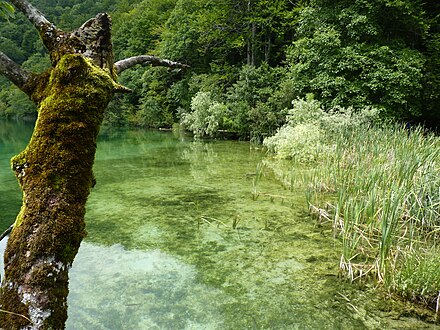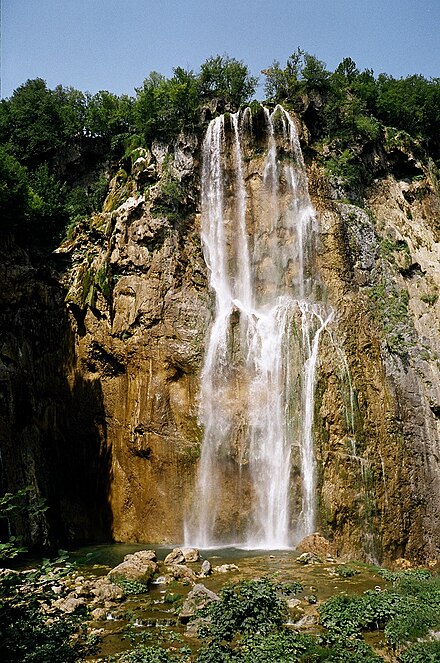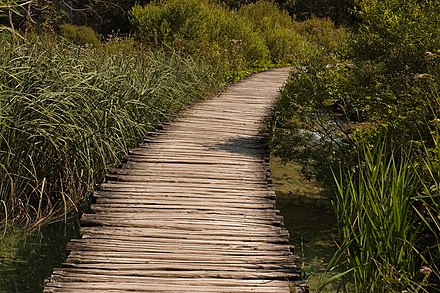Plitvice Lakes National Park - national park of Croatia, a UNESCO World Heritage Site



Understand
History
Humans have inhabited the Plitvice Lakes area for thousands of years. It was settled in turn by Illyrians, Thracians, Celts, Japods, Romans, Avars, Slavs and Turks. The area fell to the Ottomans in 1528, and was retaken by the Austrian Empire 150 years later. The Austrians incorporated it into their Military Frontier and, in addition to the native Croats who already inhabited the region, Serbs who had fled Ottoman repression settled there.
The Plitvice Lakes became a major tourist attraction in the late 19th century. The first hotel was built in 1896, and as early as 1893 it had a conservation committee – the predecessor of today's national park authority. In 1949 the communist government of Yugoslavia nationalized the lakes and made them a national park. The park was inscribed on the UNESCO world heritage list in 1979 in recognition of its "outstanding natural beauty, and the undisturbed production of travertine (tuff) through chemical and biological action".
The park soon became one of Yugoslavia's most popular tourist attractions. In March 1991 it became the scene of the Plitvice Lakes incident - the first armed confrontation of the Croatian War of Independence that resulted in fatalities. The park was held by forces of the Republic of Serbian Krajina during the conflict and suffered some damage in the process, with hotels and other facilities being used as barracks. A massacre of three children by the Yugoslav Army occurred around Grabovac in September of 1991. It was retaken by the Croatian Army in August 1995 during Operation Storm, which ended the Croatian war.
The war led UNESCO to add the park to its List of World Heritage in Danger. Due to the economic importance of the park, the Croatian government made it a priority for its de-mining efforts, and in December 1998 UNESCO recognized the parks new mine-free status by removing it from the list of endangered sites. The surrounding municipalities outside the park boundaries still have minor problems with mine contamination.
Landscape

The lakes are on the Plitvice plateau, between the mountains of Lička Plješevica (Gornja Plješevica peak 1,640 m), Mala Kapela (Seliški Vrh peak at 1,280 m) and Medveđak (884 m). The 26 lakes are separated into an upper and lower cluster formed by runoff from the mountains, descending from an altitude of 636 m to 503 m over a distance of some 8 km, aligned in a south-north direction. The lakes collectively cover an area of about 2 km², with the water exiting from the lowest lake to form the Korana River.
The Plitvice Lakes lie in a basin of karstic rock, mainly dolomite and limestone, which has given rise to their most distinctive feature. The lakes are separated by natural dams of travertine, which is deposited by the action of moss, algae and bacteria. The encrusted plants and bacteria accumulate on top of each other, forming travertine barriers which grow at the rate of about 1 cm per year.
The lakes are renowned for their distinctive colours, ranging from azure to green, grey or blue. The colours change constantly depending on the quantity of minerals or organisms in the water and the angle of sunlight.
The lakes are divided into the 12 Upper Lakes (Gornja jezera) and the four Lower Lakes.
Flora and fauna
The Plitvice Lakes national park is heavily forested, mainly with beech, spruce, and fir trees, and features a mixture of Alpine and Mediterranean vegetation. It has a notably wide variety of plant communities, due to its range of microclimates, differing soils and varying levels of altitude.
The area is also home to an extremely wide variety of animal and bird species. Rare fauna such as the European brown bear, wolf, eagle, owl, lynx, wild cat and capercaillie can be found there, along with many more common species. At least 126 species of birds have been recorded there, of which 70 have been recorded as breeding there.
Climate
.JPG/440px-Plitvice_Lakes,_Croatia,_Galovac_jezero_(5).JPG)
In winter, heavy snowfall can be expected, enabling the Mukinje Ski Resort to operate from December to early March. Fog is common in the morning and can occur very locally, making driving up and down the often narrow roads in the park hazardous.
Tourist information
- Nacionalni park Plitvička jezera (Plitvice Lakes National Park), Josipa Jovića 19, Znanstveno - stručni centar "Dr. Ivo Pevalek", HR 53231 Plitvička jezera, 44.87829°, 15.62305°, +385 53 751 015, info@np-plitvicka-jezera.hr. 07:00-20:00. Nov-Mar 60 kn; Apr-May 100 kn; Jun-Sep 250 kn; Oct 100 kn; 2-day cards 90, 160, 350 kn respectively; discounts for students (an ISIC student card is required) and children; tickets sold at the entrances and they are also valid for park's internal buses and ferries. Tickets often sell out leaving people disappointed at the park gate. To avoid this, buy your tickets online a minimum of two days in advance. If you plan on purchasing tickets at the entrance do arrive early, especially on weekends 2019-09-21
Get in
By bus
Some buses from Zagreb (83 kn) and Zadar or Split take a route along the road which passes by the park entrances. Ask the driver beforehand to make a stop at the either park entrances: entrance 1 📍 or entrance 2 📍. Among the other direct connections are Biograd na Moru, Vodice, Šibenik, Primošten, Trogir and even Novalja (island of Pag). Also there is a direct bus connection to the Krka National Park.
Buses in Croatia often do not run on time. They can come early or late, and either way they stop only long enough to pick up riders and then continue on their way. Especially in a place like Plitvice, which is quite a distance from other stops on a bus route. So get to the bus stop early and plan on waiting for a while. Bus schedules are usually posted at the tickets office at the entrances, but they may not reflect seasonal changes.
- Eurobusways (city-to-city transfers), Zsigmondy 2 (from Budapest to Plitvice lakes), +36702821827, info@eurobusways.com. door-to-door fast shuttle bus from Budapest to Plitvice lakes. To park entrance or any location around. Daily bus from June 60 € 2020-04-11
By taxi
Taxi drivers will await near the bus stations, more so entrance 2 than entrance 1, and will offer to drive for the same price of the bus ticket if around 10 persons are willing to take the taxi. It costs the same, takes an hour less and most probably they wouldn't charge for the extra baggage (The bus service charges extra). If the taxi driver is kind enough, he will also provide something like a tour guide and will leave you close enough to your destination. If for example you are waiting for the Zadar bus at 17:00, a taxi driver will be waiting 15 minutes early to attract customers, and when arriving at Zadar, if your are going to take the ferry, the driver might leave you near the pier.
Get around

On foot
The paths near the entrance of the park are extremely well maintained and it is a relatively short walk (about 1 hour) around the nearest lake.
Paths, mostly made of wooden planks or gravel, will take you through the whole park. In most places they are wide, but since the park is extremely well visited they can feel very crowded during the day.
The park have made some different routes through the park so it is easy to choose how much you want to or have time to see. A walk from one end of the park to the other normally takes around 4 hr, but due to the unique views the park offers it is a shame to be in a hurry. Take your time and enjoy it. The buses and boats are free so it is possible to plan a walk zig-zagging up or down the lakes and the many waterfalls, and then not have to walk back the same way.
Many of the paths can be used by disabled persons, but since there are a few steps here and there is some height differences between the lower and the upper lakes it will take a strong helper to get around with a wheelchair.
By boat
2 lines of small electric ferries connect far banks of the Jezero Kozjak, a bigger lake close to the entrance #2. One ferry crosses from north to south and at west end of the lake. The other ferry travels between the north terminus at the west of end of the lake to a terminus as the east end of the lake. Visitors can ride the north-south ferry as much as they like, but can only make a single one way trip on the east - west ferry (i.e. a single trip east or a single trip west).
The cost of the ferries are included in the entrance ticket.
By bus
2 shuttle bus lines run along the lakes (which are useful to take you up hills and to the entrances). The buses travel between station 1 (west of Entrance #1), station 2 (north of entrance 2), and station 3 (near Prošćansko jezero, the highest of the Upper Lakes),
The costs these buses are included into the entrance ticket.
See
Plitvice Lakes National Park is perhaps the most beautiful natural wonder in Croatia. In addition to the numerous waterfalls, a bevy of wildlife can be seen, including fish, frogs and a variety of bird species. Special attractions at Plitvice include the Veliki Splat, a 30-m waterfall surrounded by nearby boulders to which tourists have access. There is also a large waterfall complex that can be access via a cave in the surrounding rock face.
Upper Lakes (Gornja jezera)
- Prošćansko jezero (Shrubbery lake or desired lake) at the highest lake of the National park , as well as the second largest by area and the second deepest.
- Ciginovac
- Okrugljak Despite the name meaning "round lake", this lake isn't all that round. The ca. 20m high waterfall _Lobudovac_links Ciginovac with Okrugljak.
- Batinovac
- Veliko jezero Despite the name translating to "big lake", it is one of the smaller ones
- Malo jezero This name too ("small lake") is somewhat misleading, as it is 0.5 ha larger than the "big lake"
- Vir
- Galovac A bight is home to Galovac Waterfall At the highest waterfall in the Upper Lakes. North of this one there's the ca. 20 m high Prštavci waterfall.
- Milinovo jezero
- Gradinsko jezero Gradinsko comes from gradina which means "castle ruin". The name derives from the medieval Krčingrad ruin (also Kozjak ruin) which is on the peninsula between Gradinsko jezero and Kozjak.
- Buk
- Kozjak (Goat lake,) The biggest and deepest lake in the national park. On an island in the lake (today called Štefanijin otok) goats are said to have been protected from wolves once.
Lower Lakes (Donja jezera)
- Milanovac (524 m)
- Gavanovac
- Kaluđerovac
- Novakovića brod
Do
The main attraction is obviously the hiking and walking in the area. Swimming is not allowed anywhere in the park.
Walking
- Upper Lakes, 44.8751°, 15.6078°. A series of smaller lakes and waterfall cascades between Proscansko lake and Kozjak lake. Numerous walking trails lead visitors around the lakes. The lakes can be reached from Entrance 2 by crossing Kozjak lake with a ferry, which is included in the admission fee. Alternatively, a shuttle bus can be taken to the highest lake and then descended back to the ferry terminal by foot to avoid the climb. There are good indications of walking trails in the park, so a map is not necessary. 2016-08-06
- Lower Lakes, 44.89947°, 15.61084°. A chain of lakes below Kozjak lake, carved out in a canyon. Walking trails lead visitors around and over the lakes. The Lower Lakes can be reached from Entrance 1, or from Entrance 2 after traversing Kozjak lake by ferry, which is included in the admission fee of the park. The largest waterfall (Veliki Slap) can be found near Kaluderovac lake. 2016-08-06
- Šupljara cave, 44.90003°, 15.61177°. A cave system between Gavanovac lake and Kaluderovac lake. Stairs are carved out into the rocks, allowing visitors to ascend up to the canyon ridges, or descend down to the hiking trails along the waterfront. The stairs are moist and steep, so good walking shoes are required. Not recommended for children. 2016-08-06
Tip: If you arrive at the same time as a big group, walk one of the very well established routes in reverse. You'll probably be walking uphill for most of the trek, but you'll probably not see another person for a few hours.
Walking trails through the park, most of which are along the shores of the numerous lakes, are rarely steep. However, expect to climb a substantial fraction of your visit, and especially in the hot summer months this can quickly lead to dehydration. Few opportunities to buy drinks are available in the park, and the drinks sold at stands are expensive, so visitors are advised to bring the necessary water along with them into the park. Between 1 and 2 liter of water per person per day is advised. A hiking backpack is essential to comfortably carry water over long distances.
Boating
- Plitvička Jezera Boat Rental, 44.88060°, 15.61775°. 09:00-19:00. Rental service for wooden rowing boats. Visitors can explore Kozjak lake and its numerous waterfalls from the water front. Fresh water snakes can often be found sunbathing on tree trunks along the water. Swimming and fishing are not permitted in the national park. Although it is possible to cross Kozjak Lake, the boats must be returned to the pier where they are rented. Rental is 100 kn per hour 2022-07-27
Hiking
A few hiking trails are described at park's web page (dead link: December 2020) and their flyers (dead link: December 2020).
Skiing
- Ski Center Mukinje, Mukinje 55, Plitvička Jezera, 44.87119°, 15.62977°. In winter, the Ski Center of Mukinje is open, offering skiers 3 slopes with a total length of 1 km. Primarily targeted at beginners, the lift is located in the center of the town. Ski equipment can be rented locally. 2016-08-06
Buy
Numerous souvenir shops can be found near the entrances of the park. Caution is advised however, as many overpriced souvenirs sold as "authentic hand crafts" from Croatia are made in China.
- Robni Centar, D1, 53231, Plitvička Jezera, 44.87406°, 15.62828°, +385 53 751 099. 09:00-20:00. Supermarket selling a variety of drinks, cooled and uncooled. The most common bottled water of Croatia is Jana, available as mineral water or in many flavored versions. Around 5 - 10 kn per bottle. 2016-08-06
Eat
The park offers few opportunities to buy food, with the exception of food stalls and restaurants around the entrances and ferry terminals. A large picnic area can also be found near the ferry terminals. All restaurants are managed by the park authority, and the food quality they serve is low compared to the prices they typically charge. Restaurants in the numerous hotels at the park entrances suffer the same problem. Visitors are advised to bring their own food into the park if possible (and of course, take the trash out as well!) The neighboring villages offer better eating opportunities, but require a short walk from the park entrances.
A local specialty are pancakes, which are typically served with Nutella or ground walnuts. Prices between 15 and 25 kn. Most restaurants or konobas have them on their menu in the desert or snack section.
- Bistro Vučnica, Mukinje 55, 53231, Plitvička Jezera, 44.87153°, 15.62935°, +385 51 751 282. 07:00-22:00. Mid-range restaurant in the center of Mukinje, on a 15-minute walk from park entrance 2. Large selection of fresh pizzas for 60 - 90 kn. The largest pizza size is meant for 2 to 3 people. Indoor and outdoor seating available. 2016-08-06
- Robni Centar, D1, 53231, Plitvička Jezera, 44.87406°, 15.62828°, +385 53 751 099. 09:00-20:00. Supermarket selling drinks, energy bars, croissants and local pastries for breakfast or lunch, or bread and a wide variety of toppings. Fair prices. Conveniently located on the shortcut path leading from Mukinje to Entrance 2 of the park. 2016-08-06
Drink
There are few places to stock up on drinks in the park, with the exception of Kozjacka draga 📍 which has 2 drink water fountains to refill bottles. However, no large bottles can be purchased there, so travelers must bring them from outside the park. On hot summer days, a supply of 2 liters water per person is a minimum, since considerable physical effort (climbing stairs) is required to get around the park.
Sleep

There is a travel agency at the entrance to the park. From here, you can organize for a homestay. There are numerous locals who will rent bedrooms in their house and provide food for a competitive price.
Lodging
Several large hotels have been built near Entrance 2 of the park. These largely cater to middle or high class European tourists. Expect to pay very high prices for the luxury of spending the night close to the park entrance.
Private house and apartment owners in the nearby villages of Mukinje and Jezerce, both in walking distance from Entrance 2, offer rooms for better prices. In addition, visitors will have the chance to explore the lifestyle of rural Croatia and meet with local inhabitants. OpenStreetMap provides an overview of private guest houses and apartments in the area.
- Guesthouse Bor, Mukinje 59, 53231, Plitvička Jezera, 44.87155°, 15.62955°. A small guest house in the center of Mukinje, next to the skiing facilities and the only bistro of the town. €80 2016-08-06
- Miric Inn, Jezerce 18, 53231, Plitvička Jezera, 44.86795°, 15.63635°. A small inn, offering mid-range lodging. A bus connection leads to the entrances of the park. 2016-08-06
Camping
There is a camping site in the nearby town, mostly used by people visiting the park. Facilities are fine, good clean toilets, a small shop, and a couple of dining places. Camping can be made wherever you want; it is possible to choose a place between the trees, or a cosy hole in the hills or a more open place with a magnificent view.
- Cvetkovic Camping, Cvetkovic, D429, Mukinje, Plitvicka Jezera, 44.86341°, 15.63997°. Camp site 10 minutes from the park entrance. A bus stop at the main road takes guests to the park entrance. 2016-08-06
As long as you are staying at the camping site, your ticket to the park can be renewed for free at the information office. It’s a good way to spend more time at the park and visit it outside the busier hours. Parking at the park is free, but if you don't want to drive the camping site arranges buses to and from the park in the main season.
Backcountry
The national park is a restricted area, limiting the opportunities for backcountry lodging. Firewood gathering and campfires are prohibited, just like fishing and berry gathering.
Areas outside the national park boundaries may be contaminated with land mines left over from the Croatian Independence War, making it dangerous to wander into the forests and leave the marked roads.
Stay safe
This area is one of the only remaining regions of Europe where bears roam. It would probably more interesting than dangerous to see a bear, but were you to surprise a mother and her cub because you did not expect to see bears at all, you could be in danger. A lone bear is more frightened of you than you are of it. Yell and bang something that makes loud noises, and the bear will almost always run off. Bears can run and climb faster than you can, and running signals “prey,” so don’t run.
As mentioned above, land mines may still be present in the forests around the national park, being relics left over after the Croatian Independence War. Although the park itself is cleared from mines and safe, do not wander off trails in forests outside the park boundaries.
Go next
- Zadar, a port city and destination of many of the long distance coaches traveling through the Plitvice area.
- Zagreb, the capital and largest city of Croatia with many sights.
- Rijeka, the largest city in the Kvarner region.
- Split, the second largest city of Croatia and home to another UNESCO Heritage site, Diocletian's Palace.
Plitvice Lakes National Park
np-plitvicka-jezera.hrCounty of Lika-Senj
Primary administrative division